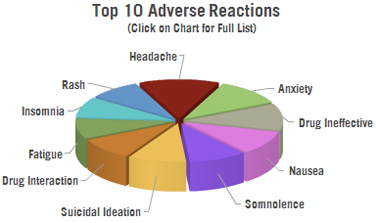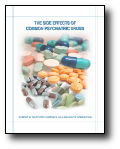 The risks of these drugs are provided so the public can make informed, educated decisions. Provigil is a stimulant drug, classified by the U.S. Drug Enforcement Administration (DEA) as Schedule II, in the same class of highly addictive drugs as morphine, opium and cocaine. The DEA states that the use of stimulants can lead to “severe psychological or physical dependence” and that “these drugs are also considered dangerous.” Provigil is also known as Alertec, Modafinil, Modiodal, Vigil.
The risks of these drugs are provided so the public can make informed, educated decisions. Provigil is a stimulant drug, classified by the U.S. Drug Enforcement Administration (DEA) as Schedule II, in the same class of highly addictive drugs as morphine, opium and cocaine. The DEA states that the use of stimulants can lead to “severe psychological or physical dependence” and that “these drugs are also considered dangerous.” Provigil is also known as Alertec, Modafinil, Modiodal, Vigil.
To see the total figures from IQVia on the number of people taking stimulants in the U.S., click here.
Please note: No one should attempt to get off of psychiatric drugs without a doctor’s supervision. To help find medical practitioners in your area, click here.
Also, read the FDA’s Provigil Medication Guide for more information. MedGuides include “the particular serious and significant public health concern that has created the need for the Medication Guide” and notes “pediatric risks.” (Note: Unfortunately, the FDA MedGuides only work on a desktop, not on a mobile device. Please complain to the FDA to make their public advisories accessible to all. 1-888-INFO-FDA or 1-888-463-6332.)
Provigil Drug Warnings:
There have been seven drug regulatory agency warnings from four countries (Australia, Canada, United Kingdom and United States) on Provigil (or modafinil). These include the following (note that some warnings cite more than one side effect, so the list below may not be equal to the total number of warnings):
4 warnings on Provigil causing skin conditions
4 warnings on Provigil causing allergic reactions
3 warnings on Provigil causing mania or psychosis
3 warnings on Provigil causing suicide risk or attempts
3 warnings on Provigil causing anxiety
2 warnings on Provigil causing depression
2 warnings on Provigil causing hostility or aggression
1 warnings on Provigil causing cardiovascular disorders
1 warnings on Provigil causing hallucinations
1 warning on Provigil causing addiction or dependence
1 warning on Provigil causing abnormal behavior
Provigil Drug Studies:
There has been one study done in the United States showing that Provigil (or modafinil) had a lack of efficacy.
Adverse Reaction Reports Filed with the US FDA: There have been 1,357 adverse reactions reported to the US FDA in connection with Provigil.
The FDA estimates that less than 1% of all serious events are ever reported to it, so the actual number of side effects occurring are most certainly higher.
- 84 cases of headache
- 71 cases of anxiety
- 70 cases of the drug being ineffective
- 63 cases of nausea
- 61 cases of somnolence
- 61 cases of suicidal ideation
- 54 cases of fatigue
- 54 cases of insomnia
- 54 cases of rash
- 51 cases of convulsions
Documented Side Effects of Provigil:
Source: Physicians Desk Reference, National Institutes of Health’s Medline Plus, and/or the drug label.
Anxiety
Burning, tingling, or numbness of the skin
Confusion
Depression
Difficulty breathing or swallowing
Dizziness
Frenzied, abnormally excited mood
Hallucinations
Hives
Insomnia
Irregular heartbeat
Loss of appetite
Nausea
Nervousness
Nosebleed
Peeling skin
Swelling of the face, throat, tongue, lips, eyes, hands, feet, ankles, or lower legs
Suicidal ideation
Tight muscles or difficulty moving
Uncontrollable shaking of a part of your body
Click here to learn more >>
This brochure is a simple guide that documents the dangerous and deadly side effects of the drugs prescribed to millions of men, women and children diagnosed with bogus mental disorders.



 Download The Side Effects of Common
Download The Side Effects of Common
SHARE YOUR STORY/COMMENT